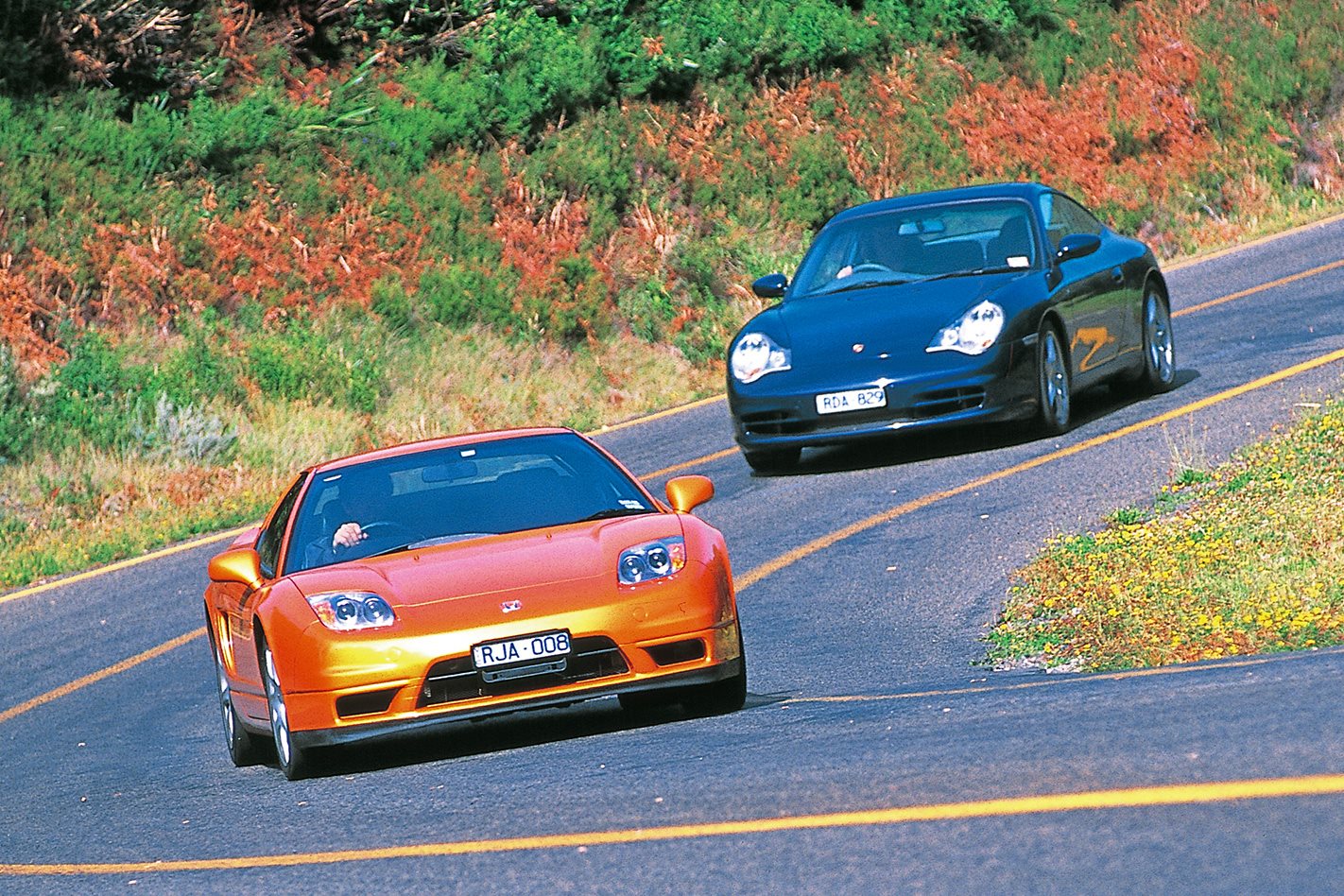Right off the bat, I know what you’re thinking: You’d buy the Porsche, right? On what basis?
This story first appeared in the May 2002 issue of MOTOR
Because it’s a proper performance car? Believe me, Bucko, so is the other hot-rod being caned up and down Calder’s main straight right now. Oh, I see, the 911 has pedigree, does it? Why didn’t you say so?
Listen, if you ever had to name a Japanese car that had breeding, you’d be hard pressed to think of a better example than the Honda NSX. The sexy, alloy-bodied Honda was J-Inc’s first real foray into proper mid-engined exotica, and it proved the point that high performance didn’t necessarily mean duff interiors and dodgy ergonomics.
Now that we’ve got that lot out of the way, what’s really going on here? Without getting into a grinding justification of this unholy pairing, let’s just say that at $254,500 and $186,000, the NSX Targa (there’s a fixed-lid coupe for $11k less) and 911 respectively are, if not in the same ball-park, at least in the same suburb of a very rarefied place.
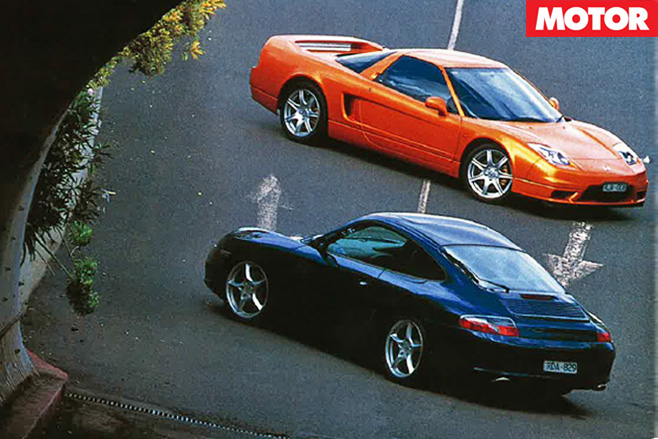
On one hand we have the establishment; the Porsche 911 with its rear-mounted flat-six, atmospheric aspiration and rear-drive. It’s a nominal four-seater, but unless you’re the cruel type, the rear seat is for soft luggage only.
The Honda is also a six-cylinder, also atmospheric and also drives its rear wheels. It is, however, a V6, mounted amidships, and it’s strictly a two-seater. It also screams old-school EXOTIC, from its cab-forward proportions to its w-i-d-e rear track and swoopy glasshouse.
The 911 is utterly, utterly familiar provided you recognise the fact that the Zuffenhausen factory continues to take big steps forward without ruining the dream. Yet, as far as I know, it has never – water-cooling notwithstanding – taken a backward one (not in 911 history, anyway). The latest version of old faithful is improved to the tune of a bigger, 3.6-litre mill, and some sensitive fine-tuning across the board.

The 3.2-litre Vee in the NSX runs a lower 10.2:1 compression ratio but still gets variable valve timing (VTec, in this case) and, interestingly, only the six-speed manual gets the new engine with its 3mm bigger bore. The auto stays with the 3.0-litre version.
The end result is an artificial one in the sense that the Japanese safety-schneds insist that no vehicle built in Nippon shall have more than 206kW lurking at its flywheel. Keeping within the letter of that law (if not the spirit) the NSX boasts precisely that power figure, developed at 7300rpm, and 304Nm at 5300 rpm.
Compare those figures and you’ll see that the Honda makes less power at higher revs and a hefty 64 fewer Nms, also at considerably higher revs. And if you know your bench racing, that should translate to a slower car with less flexibility. You’d be half right. Yes, the 911 murders the NSX across the standing 400 metres by a full second and, yes, it’s also feistier gear for gear by a noticeable margin.
But that completely ignores the suppleness of the Honda engine which, thanks to VTec, manages to make useable power from 2000rpm all the way to about 7500rpm. So while it won’t actually stay with the Porker, in isolation it’s an amazingly flexible piece of gear, especially for something with a torque peak at 5300rpm.
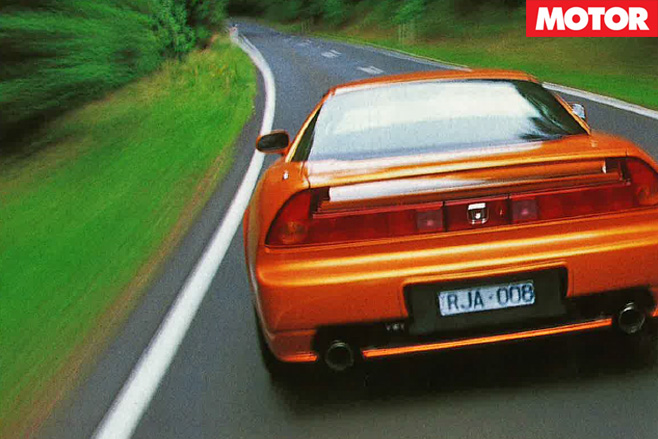
The 911’s claim to that mantle extends to the aural treat in store for you, too. The Variocam gets serious about 5200rpm at which point the wail from the flat six changes from warm honey to bandsaw-through-Bonn-Scott as it tags the redline. The only time the boxer-motor feels a bit wholegrain is at idle when there’s a tiny amount of mechanical noise and vibration that disappears at the tiniest blip on the loud pedal.
The Honda just can’t match that act and while it’s smooth and composed, it just never gives that impression of being something truly special. There’s a rumble of vibration as revs pass through about 2000rpm that feels like a bit of rocking-couple (a secondary vibe inherent in most engines) combined with too-hard engine mounts. Ultimately, though, it feels contrived rather than a consequence of an engine with its nuts tuned off.
Either car is a lesson to other manufacturers on how to make a six-speed gearbox a viable proposition rather than a marketing plot. Top gear in both is completely useable, with the flexibility allowing the tackling of hills and even gentle overtaking without a downshift. More significantly, fifth gear is also appropriate for typical arterial roads with an 80km/h limit, which is not something you can say for all such high performance gearboxes.
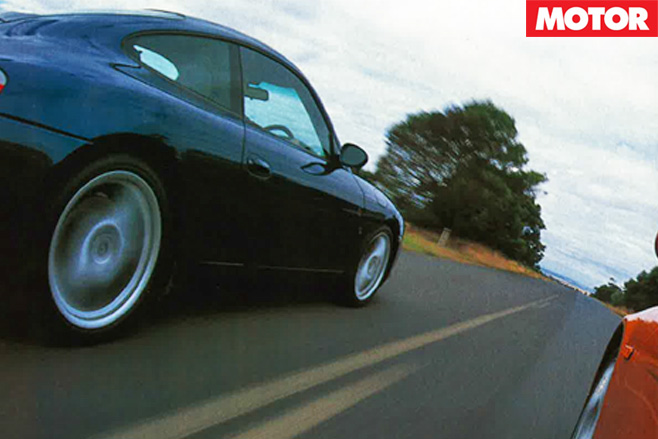
Back when we laboured over PCOTY I floated a theory that Porsche had deliberately engineered a bit of mongrel back into the car. Most particularly, that the white-coats had dialled in some of that old-fashioned throttle-off oversteer into the equation.
Why? Because there were some out there who reckoned the original 996 was just too benign. As if water-cooling wasn’t bad enough, Porsche then goes and makes the 911 totally neutral. Bastards.
Frankly, I can’t see what’s wrong with any of that, but my bet is that Porsche has taken it personally and decided to give the mob what they want. And that means a rear end that can – and will – take the lead in the right (wrong?) circumstances.
Okay, so in the 2002 car, you’ve got to be going at about 10-10ths and you’ve got to brake late as you turn into a (preferably off-camber) corner, but some will try it. And they will – in some cases – suddenly be granted a window-seat for a view of where they’ve just been.
That’s not to say that we’re back to the old rock-on-a-string days that defined the original 911, but unlike the 3.4-litre 996, the Carrera no longer feels dumkopf-proof. That contrasts with the NSX which is so neutral it’s almost other-worldly. In fact, even once you’ve run out of suspension travel and you clobber a big mid-corner bumper, all four wheels will skip sideways, which is an amazing illustration of how balanced it is.

While the 911’s rear end is a potentially very active participant – and makes itself felt at even moderate speeds – the NSX makes use of its long wheelbase (a whopping 180mm more than the 911) and merely feels as if its just harmlessly dragging its arse around, leaving all the tricky stuff to the front end.
What’s even more amazing is that the bastion of handling with acceptable ride, the 911, gets a bit of a pasting in that very department. The NSX has better small bump compliance and at the same time, less body-roll. That’s partly due to the monster track (1540mm at the rear) that helps cancel out the roll, but it also feels better damped in most situations.
That’s not to say the 911 is a dray, far from it, and while my description of it as ‘jigglier than the Honda’ had Hawley in fits, I’m sticking with it. Trying to separate ‘lively’ from ‘tactile’ is never easy, but one area where the Honda just can’t match the German is in the way they convey info back to the driver.
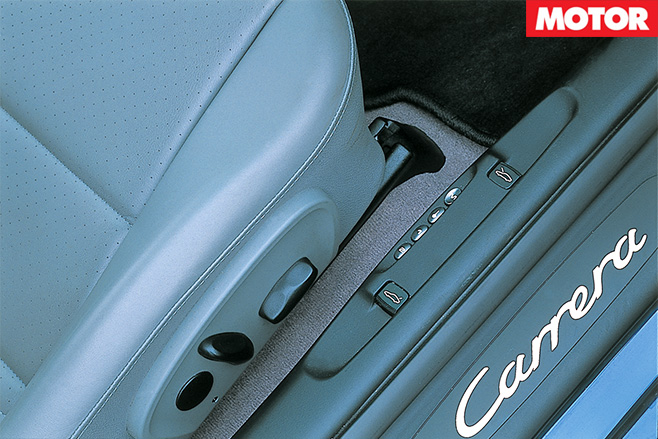
The Porsche just never stops feeding back quality info about what’s under the front tyres, which way they’re pointing and what you can expect to happen next. Accurate and quick though it is, the NSX’s steering lacks that level of communication. It’s worst at the straight-ahead and small wheel deflections reveal bugger all self-centring.
In fact, tug on a fraction of lock, take your hands off the wheel and the NSX will continue to scribe the same radius. It’s a bit spooky, to be honest, and I wouldn’t mind betting the electrically-assisted power-steering is the culprit.
Whether you value the clinical efficiency of the Honda over the three-ring circus that is the Porsche is up to you. But even women’s magazines recognise the fact that marrying for looks/money tends to be a short term solution, while relationships based on a mutual ability to provide laughs usually lasts a lot longer. (Where’d that come from?)
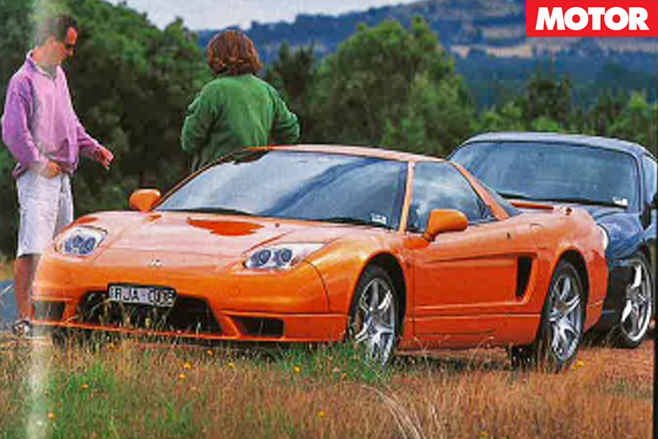
The Honda? Hmmmm. Can’t help but thinking that it’s starting to look a bit dated. Remember back in the ’80s and early ’90s when everybody was building ‘supercars’ (Bugatti, McLaren, Lamborghini et al)? Well, the basic proportions of the NSX ring too many bells from those days for me. Likewise the cabin looks like it’s pretty generic Honda of a generation ago.
It’s cramped, too, and anybody over about 180cm is going to find headroom tight. Even little things like the ignition key being too far away for taller folk start to get annoying. Oh, and how come the driver’s door, bootlid and engine cover need such a huge slam every time to shut them properly?
Despite having the same adjustable-for-reach-only steering column, the 911 boasts a more rational driving position and much easier entry/exit. There’s more room in every direction and while it doesn’t quite have the same boot space as the NSX, there’s always that back seat for extra storage. And you’ve gotta love that instrument cluster.

Only problem now is that the game has moved on and even the supercar establishment like the 911 (actually, especially the 911) is as civilised as anybody could ever want. The real magic of the 911 is that it retains all those elements that made it so fabulous back when dinosaurs roamed the Earth, yet it’s managed to adapt and evolve to the point where it’s still, by any standards, one of the most sensuous, involving cars you can buy at any money. That it’s a full 70 grand less than the NSX is the final nail in the Big H’s coffin.
So yeah, I know what you’re thinking… and you’d be right. You’d buy the Porsche.
Future Primitive
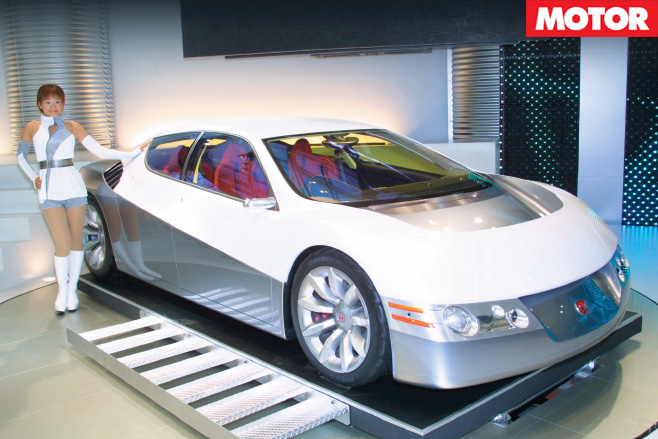
The trend spawned all sorts of lunacy, from the gothic-looking Bugatti EB110, right through to the aerospace-inspired Vector out of the US. Some made it; the McLaren F1 and Jaguar XJ220 stand out as examples worth owning, but of them all, only one was the sort of thing you’d stick granny in to do the shopping.
And wouldn’t you know it, it was Honda that managed to bridge the gap between mid-engined layout and real-world driveability. The first NSX lobbed in 1991 with a 3.0-litre V6 and 188 kW. There was a choice of four-speed auto or five-speed manual, although the manual was the clear performance leader since the engine wasn’t exactly a torque factory.
The wheels and tyres went from 15-inch front/16-inch rear to 16-inch front/17-inch rear in 1994, and the NSX-T (Targa) model lobbed in 1995. At the same time, the auto got a steering wheel-mounted paddle shift, and in 1997 the 3.2-litre mill was specified for the manual versions, along with the six-speed ’box.
What’s perhaps most interesting is that the latest version isn’t radically different to the original. Then again, since most of the other supercars are now landfill, the whole market segment hasn’t really moved on.
Meantime, the things that bugged the NSX then are the same things that make us groan now. Namely, the way it’s so drivable at the expense of a little excitement; and, of course, the monstrous price-tag. Even in 1991, it was a whopping $170,000. Mind you, a 911 Carrera was only about five grand cheaper back then, making the German car the real bargain these days.
So where to now for Honda’s friendly supercar? The much touted V8 didn’t arrive in time for this update and may never happen. Probably the closest hint for NSX direction is the Dualnote concept car spotted on the Honda stand at the last Tokyo motorshow. The Hybrid get its primary motivation from a 3.5-litre V6. Apparently, it is quicker than the current NSX.
Don’t hold your breathe for production, though.
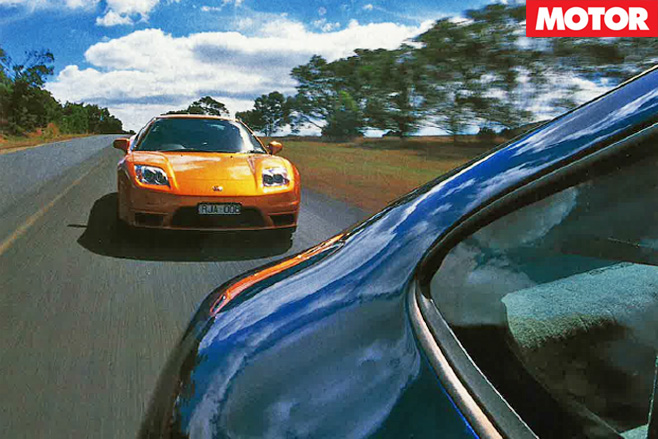
FAST FIGURES
| u00a0 | Honda NSX Targa | Porsche 911 Carrera |
| 0-10km/h | 0.43 | 0.30 |
| 0-20km/h | 0.81 | 0.65 |
| 0-30km/h | 1.18 | 0.98 |
| 0-40km/h | 1.72 | 1.31 |
| 0-50km/h | 2.29 | 1.76 |
| 0-60km/h | 2.87 | 2.19 |
| 0-70km/h | 3.76 | 2.98 |
| 0-80km/h | 4.29 | 3.60 |
| 0-90km/h | 5.12 | 4.22 |
| 0-100km/h | 6.04 | 4.98 |
| 0-110km/h | 7.23 | 5.74 |
| 0-120km/h | 8.27 | 6.88 |
| 0-130km/h | 9.53 | 7.88 |
0-400m | 14.24 @ 162.7 km/h | 13.17 @ 174.5 km/h |
FAST FACTS
| u00a0 | Honda NSX Targa | Porsche 911 Carrera |
| Body | two-door coupe | two-door coupe |
| Drive | rear-wheel | rear-wheel |
| Engine | mid-mounted 3.2-litre DOHC 24-valve V6 | rear-mounted 3.6-litre DOHC, 24-valve flat-six |
| Power | 206kW @ 7300rpm | 235kW @ 6800rpm |
| Torque | 304Nm @ 5300rpm | 370Nm @ 4250rpm |
| Compression Ratio | 10.2:1 | 11.3:1 |
| Bore x stroke | 93mm x 78mm | 100mm x 76.4mm |
| Weight | 1425 kg | 1345 kg |
| Weight/power | 6.9 kg/kW | 5.7 kg/kW |
| Specific power | 64.4 kW/litre | 65.3 kW/litre |
| Transmission | six-speed manualu00a0 | six-speed manualu00a0 |
| Suspension | double wishbone, coil springs,u00a0 anti-roll bar (f); double wishbone, coil springs, anti-roll bar (r) | MacPherson struts, coil springs, anti-roll bar (f); independent multi-link, coil springs, anti-roll bar (r) |
| L/W/H | 4430/1810/1175 mm | 4430/1770/1305 mm |
| Wheelbase | 2530 mm | 2350 mmu00a0 |
| Tracks | 1510 mm (f); 1540 mm (r) | 1465 mm (f); 1480 mm (r) |
| Brakes | 298 mm ventilated discs, four-piston calipers (f); 303 mm cross-drilled discs, two-piston calipers (r), ABS | ventilated and cross-drilled, four-piston calipers (f); ventilated and cross-drilled discs, two-piston calipers (r), ABS |
| Wheels | 17 x 7-inch (f); 17 x 9-inch (r), alloy | 17 x 7-inch (f); 17 x 9-inch (r), alloy |
| Tyres | Bridgestone S02 215/40 ZR17 (f); 255/40 ZR17 (r)u00a0 | Pirelli P Zero Rosso, 205/50 ZR17 (f); 255/40 ZR (r) |
| Fuel | 70 litres, PULP | 64 litres, PULP |
| Price | $254,000 | $186,000 |

